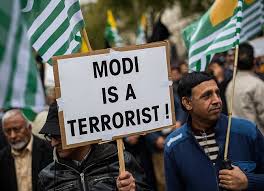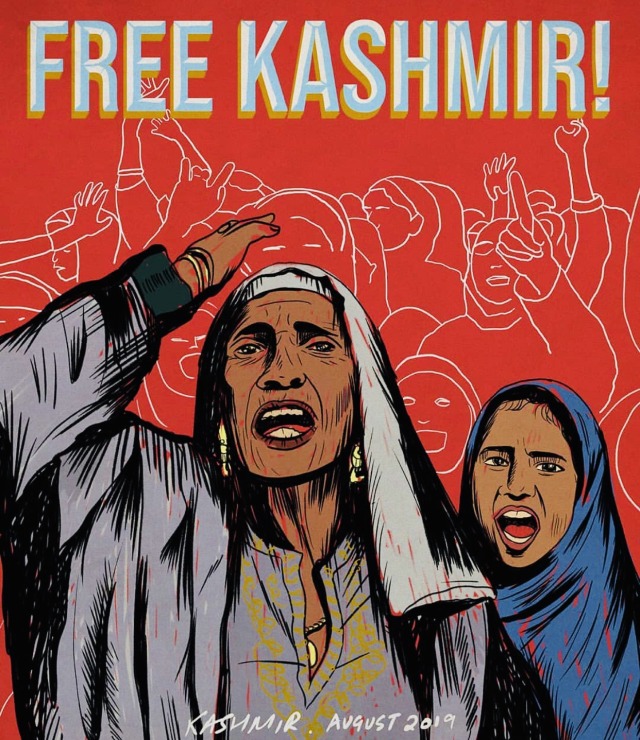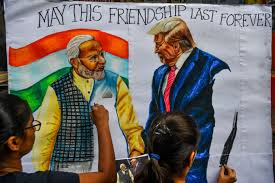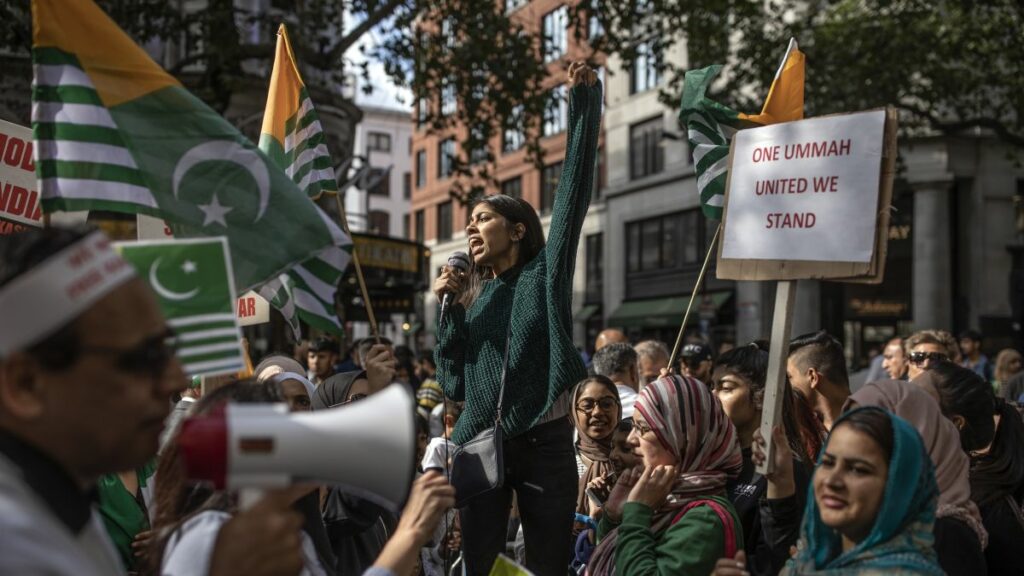Authoritarianism and resistance in India (part 2)
The Modi Project

In the second part of this three-part interview, Nagesh Rao discusses the broader context and meaning of the right-wing authoritarian project of Prime Minister Narendra Modi. Part One examined the causes and significance of ongoing mass farmers’ protests in India, which have been some of the largest mobilizations in world history. Part three explores the state of the opposition to Hindu nationalism in India and abroad.
Ashley Smith: What are the goals of the Bharatiya Janata Party (BJP) and Narendra Modi in implementing these new farm laws? What are the economic and ideological components?
Nagesh Rao: The changing rural demographics that I mentioned before (see Part One) provides a hint. It’s significant that we see a dip in the number of landholding farmers and a steep increase in the number of landless laborers in the years 2001-2011. These were the years of the so-called “Indian miracle,” but for workers and peasants it’s been an Indian mirage. After more than three decades of liberalization, India ranks 131st on the Human Development Index but is now among the top five in the number of billionaires.
You might remember that it was in 2005 that Thomas Friedman spent a few days in luxury hotels in Bangalore and came back crowing about globalization lifting all boats and making the world flat. 2008 was the year of the movie Slumdog Millionaire, with its rags-to-riches tale that introduced global audiences to post neo-liberal-reform India and to the new Indian Dream. These were the years when the “gush-up economy,” as Arundhati Roy calls it, was firing on all cylinders.
By 2013, the luster was off, and since then the economy has grown at an anemic pace. So Narendra Modi came into office in 2014 promising “sabka saath, sabka vikas” (together with all, development for all) but with little steam left in the economy to actually deliver. To sustain and prop up accumulation, the government cut corporate taxes, to restore credit they slashed interest rates, and to attract investment they announced further privatizations. They passed the new labor laws I mentioned earlier (see Part One). In some BJP-ruled states, they’ve also passed laws to lengthen the workday to 12 hours, while in others they are proposing to suspend all labor laws for a period of up to 3 years.
And yet, well into Modi’s second term the economy remains trapped in sluggish growth with stalled industrial production, falling investment, falling exports, a banking industry that is saddled with an astounding $130 billion or so in non-performing assets, and a crisis-ridden financial sector. Unemployment, before COVID, was higher than it had been in 45 years. The year prior, the economy had grown a mere 4.2 percent. And they introduced a new formula to calculate GDP making even that growth figure suspect.
Amidst all this, capital demands more—more deregulation, more privatization. So here we are, with these farm laws that aim to liberalize agriculture with the big corporate interests in mind.
But in India’s federal system, the Union (central) government has no jurisdiction over agriculture and agricultural land; state governments do. So the BJP and Modi face an obstacle here. The wide variation in state laws governing land and labor is also a headache when it comes to land acquisition. So it seems to me that further liberalization of the rural economy will necessarily involve strong-arming the states.
Aaron Amaral: Wouldn’t this situation create a backlash from the states?
NR Yes, but the 2019 election seems to prove that it doesn’t matter. The BJP and its allies hadn’t fared so well at the state level, but they handily won the national elections. According to an NDTV analysis, BJP’s vote share dropped sharply in ten state assembly elections held since 2018 (a year before Modi’s second term began). In 2018-19, the decline of BJP’s vote share at the state level led many to believe that Modi wouldn’t win re-election. So what happened?
With the terminal decline of the Congress Party there is no viable challenger to the BJP in national polls, nor is there likely to be one in the foreseeable future. It is not easy to create the kind of nationwide political implantation and infrastructure that Congress had in its heyday. So there will be all sorts of attempts at mahagathbandhans or grand alliances against the BJP, as there have been in some states (most notably in Bihar), but India’s political elites are notoriously fickle and opportunistic, so I’m not holding my breath.
There’s a tension here, that’s probably characteristic of all federal setups, between the centralizing demands of capitalist nation-states and the centrifugal tendencies of subnational and provincial interests. So that NDTV analysis is right—the BJP is emerging as a party not just of the center, but for the center; it has no base in the states, while no other party is able to form a stable government in Delhi.

I think the BJP will run in state elections by fanning communal (inter-religious) tensions where they can and drawing on national leaders’ prestige where they can’t. They will rule from the center with indifference to either the resulting carnage or even to short-term electoral losses in the states. In the long run, they will use their power at the center to further privatize and liberalize on behalf of capital, mostly domestic but also foreign; to reshape the nation and its institutions to better reflect Hindutva ideology; to advance a settler-colonial project in Kashmir and (this is their delusion) maintain tensions at a low boil to justify continued colonization and a massive military presence in this strategically and economically significant region. These will be wrenching processes, but they will broaden and deepen the hegemony of Hindu nationalism, which in turn will ensure that the fascists stay in power unless and until there’s a viable national alternative.
AS: Can you say more about how Kashmir fits into BJP’s project of centralizing authority and its relationship to Hindu nationalism?
NR: Kashmir is a special case because it is a colony of India. Its state institutions reflect that relationship. So in that sense there’s no comparison to be made between Punjab or Haryana or Tamil Nadu, whose authority the government would like to override but who are fully integrated as states in the Indian Union, and Kashmir.
In Kashmir, where the vast majority are Muslims, there is a near-total rejection of Indian rule, and a generations-old struggle for popular sovereignty whose roots are older than 1947 and the creation of India and Pakistan. In that period, in the 1930s, the struggle had peaked under Kashmir’s last king, Hari Singh. With the British leaving the subcontinent (in shambles) in 1947 and facingmass rebellion and unrest, Hari Singh abdicated by acceding to India, and called for Indian military help. Independent India’s first Prime Minister, Jawaharlal Nehru, himself a Kashmiri Pandit, happily obliged, promising to hold a plebiscite to determine the will of the people once they’d dealt with the situation. That plebiscite never came, and when Kashmiris elected Sheikh Abdullah with his socialist-influenced progressive manifesto for a New Kashmir as their Prime Minister, and he demanded self-determination for his people, the “socialist” Nehru threw him in jail for 11 years. Successive Indian governments have rigged Kashmiris’ elections; jailed, killed, or co-opted their leaders; and waged a dirty war of occupation against them for over three decades now. More than 80,000 people have been killed, thousands “disappeared,” but the struggle continues.
Of course there’s no democracy in Kashmir; it’s occupied by nearly 700,000 Indian troops. There are no perfect analogies, but it’s like the French in Algeria. First they occupied, then they settled and grabbed the best land, then they waged a war against the indigenous population in which they killed a million people before relinquishing control. While Indian troops have committed all sorts of atrocities—from extra-judicial executions in staged “encounters” with “terrorists” to the widespread use of torture to mass rapes, abductions, and forced disappearances—the Armed Forces Special Powers Act (AFSPA) shields the military from civil prosecution. Kashimiri activists and advocates like Parvez Imroz, Khurram Parvez, Ifat Gazia, and others have tirelessly and courageously documented these atrocities, and journalists have been jailed or have paid with their lives for telling the world about what’s going on.

This is the context for the BJP government’s latest actions. Let’s go back to 2019 and think about how and why Modi won a second term. The BJP was trailing in vote share in state after state in recent elections, news on the economic front was miserable, and what happened? A suicide attack on an Indian paramilitary convoy in Pulwama, Kashmir killed 40 soldiers. In dramatic fashion soon after, the Indian Air Force struck what it claimed were “terror camps” in Balakot, across the border in Pakistan. Cue the nationalist hysteria and warmongering in the media for weeks on end during and after that, and Modi’s comeback was assured.
Soon after the election, on August 5, 2019, the BJP launched a new, settler-colonial phase of India’s decades-long colonial project. They held a rushed charade of a “debate” in Parliament and nullified Articles 370 and 35A of the Indian Constitution by a trick of legal jugglery that would not hold up in an independent court.
Article 370 had guaranteed the State of Jammu and Kashmir (J&K) a special status and a degree of autonomy—which had steadily been eroded over the decades since Independence—from the Union government. Article 35A allowed Kashmir’s state legislature to determine who was a permanent resident, and only permanent residents were accorded certain privileges, such as availing state scholarships or, crucially, acquiring property. The removal of Article 370 meant that some 160 Indian laws that were alien to J&K now became the law of the land. Cynically enough, not all laws though,laws restricting land acquisition were held off and since 2019 large tracts of Kashmiri land have been “allocated” by the Indian government for private investment and for military use.
They bifurcated the state and demoted both parts to the status of Union Territories that would no longer have their own legislative body but would be governed directly by the Government of India.
The BJP didn’t do this without parliamentary discord. Some parliamentarians walked out, while others gave speeches in defense of federalism, like Congress Party stalwart P. Chidambaram who said “you are making states your vassals; you have reduced states to colonies!” Yes, these words were actually uttered in the Indian Parliament. Of course, he could have added, “Many in my Party are jealous that we didn’t do it better,” but he didn’t. Anyway, for his troubles, the veteran parliamentarian and former Cabinet Minister was charged with corruption and thrown in jail for 106 days without bail.
This “debate” was taking place in Parliament even as J&K was under a severe crackdown; land and mobile communications were cut and there was a complete media shutdown. Kashmiris, whose fate was being decided in Delhi’s Parliament, were of course not consulted. They likely suspected something big/bad was about to happen, and many probably suspected it had to do with Article 370. But they couldn’t even listen in, let alone participate in the “debate.” And what is there to debate if you have a gun pointed at my head?
For weeks the government had been spreading rumors about impending “terrorist” attacks in Kashmir. On this pretext they sent in 80,000 additional troops into the state (already the most heavily militarized region in the world), then imposed a strict curfew and communications blackout, and then held their debate in Parliament to scrap Article 370. The BJP-appointed (non-Kashmiri) Governor ratified the decision and although this maneuver would not withstand judicial scrutiny in an independent court, there is little danger of that happening in Modi’s India, where the Supreme Court has taken to meekly rubber-stamping government policy. In either case, a few months later they argued in court that the abrogation of Article 370 was a fait accompli and there’s nothing the court could do, and the court seems to have agreed.
Full incorporation of Kashmir into India has been a long-standing goal of all Indian nationalists, and the Hindu right have been calling for the abrogation of Article 370 for a while. And yet, it’s astonishing to know that they got away with it. They were quite audacious, really. Sure, Congress-led governments of the past got away with mass atrocities in Kashmir, but their strategy was to maintain the figleaf of Article 370 and rule by propping up collaborationist politicians. BJP tore up the fig leaf, placed the collaborationist politicians under house arrest, and jailed hundreds of other Kashmiri activists and leaders for several months following the August 5, 2019 decision. Some of them might still be in jail.
Egged on by corporate media and social media campaigns, or by Whatsapp University (as NDTV’s Ravish Kumar calls it), people celebrated the decision (many of them no doubt from the very states that are now being bulldozed by BJP’s farm laws) and the BJP got another boost in ratings. It’s no wonder that the BJP introduced the new anti-Muslim citizenship law a few months later that year. Having succeeded thus far in managing the PR fallout it’s no wonder that they felt they could override states and liberalize agriculture from on high. But I doubt that they expected the mass protests that erupted across the nation in the wake of the CAA’s passage. The anti-CAA protests and the farmers protests hold out hope that the BJP and Hindu nationalism can still be defeated.
AS: One question that flows from this is comparing the BJP as one expression of the rise of a new international far right. What you’re describing is a much more coherent project when compared with other far-right governments in the world. It is a Hindu nationalist, bourgeois political project to transform the political economy of the whole, of the Indian state. So when you look at the different far right governments – in the U. S., Brazil, India, Turkey, Hungary—where there’s been a whole argument about how to characterize these governments fascist, not fascist—how do you position Modi’s government in that continuum of the global far-right governments?
NR: I would call Trump an accidental fascist—he didn’t expect to land this job, but he did. On the other hand, Modi and Home Minister Shah are seasoned politicians of the far right, and the BJP and its affiliates in the Sangh Parivar have been at this project for about a hundred years now, if we count from 1925 the year the RSS was founded. So yes, they have a more coherent program and project than Trump has had, for sure. And they certainly take a longer-term view of things.
I mentioned the Sangh Parivar. It’s an alliance (parivar means family) of Hindu chauvinist organizations, with the Rashtriya Swayamsevak Sangh or RSS (National Volunteer Organization), which claims a membership of 4-5 million, at its head. The BJP may not have the kind of implantation that Congress had, but they rely on the rank and file of fascist organizations that do; including the RSS, VHP, Bajrang Dal, the student organization ABVP, and dozens of smaller and less known vigilante squads that engage in all sorts of violence from virtue policing to lynching to rioting to murders and assassinations, targeting Muslims and Christians, leftists, rationalists, and anyone they deem “anti-national.” The membership of these organizations runs in the many millions and the three decades of BJP’s ascendancy has seen the spread and further implantation of these groups.

Today, India is a colonial power and an authoritarian democracy where state institutions have been captured by fascists, where Hindutva ideology is increasingly hegemonic, but where social struggles remain widespread. For Hindutva’s “others” it means accepting second-class citizenship and living in silence and fear. Of course, this is in India; the situation in Kashmir is dire, as Kashmiris face the prospect of being pushed to the margins of their own society and economy, or an even worse fate, as Indian capital and settlers move in. Is this a fascist state? It’s still a democracy, but no one would call it “robust” anymore.
Harkening back to the 1975 imposition of a state of emergency by Indira Gandhi’s Congress government, Arundhati Roy and others have been referring to the current situation as an “undeclared emergency.” There’s been no declared suspension of civil liberties or fundamental rights, and yet dissenting voices have been locked away with impunity by a state that is answerable to no one, not even the judiciary.
I’m thinking of the Bhima Koregaon 16. In 2018, Hindu nationalist mobs attacked an annual gathering of thousands of Dalits. Two people died and dozens were injured. In response, instead of going after the Hindu nationalists, the National Investigation Agency (NIA) launched a witch-hunt against Dalit and Adivasi rights activists and advocates. Three years later, the leaders of the attack walk free, while sixteen scholars, professors, writers and researchers, and anti-nuclear, anti-communalism, Dalit rights, Adivasi rights, Kashmiri rights activists and advocates have been arbitrarily arrested and detained with no hope of release or trial. This witch-hunt has identified a new threat to the nation: “urban Naxals” or urban supporters of banned Maoist groups.
AA: How have people responded? How widespread is the support for Hindu nationalism and why?
NR: At the popular level, the normalization of Hindutva ideology has had a stifling effect on culture and consciousness. I said earlier that the BJP is backed by big capital. The urban middle classes have also, with particular fervor, shifted into Modi’s camp, drawn by the allure of “development,” which to them means a clean break with the Nehruvian legacies of state-capitalism, welfare-statism and social liberalism. Moreover, upper caste disdain for the lives of lower caste workers and peasants inures them to the barbarities of fascist violence.
As always with the middle class when fascism is on the rise, it’s not only economic; it’s also ideological. Modi’s middle class base is unified today by a muscular Hindu nationalist identity that worships capitalism and adores its leader. There’s been a palpable shift in urban public culture, and while ostentatious displays of Hindu piety were never uncommon in Indian cities, the phenomenon of Muslims being forced by Hindutva goons to chant “Jai Shri Ram” (“Victory to Lord Ram”) is relatively new.
After the 2019 elections Achin Vanaik wrote that there was a time when we might have called this sort of Islamophobia a fringe element, but there’s no room left for such illusions. He asked, what does it mean when someone like Pragya Thakur, an accused murderer who repeatedly asserted her admiration for Nathuram Godse, the man who assassinated Mahatma Gandhi, wins elections by a margin of hundreds of thousands of votes?
Fascism as a mass movement has its moments of spectacle, but fascist culture embeds itself in popular consciousness in molecular ways, and in India it has found fertile soil for two critical reasons—colonialism and caste. By colonialism, I mean that post-independence India is a colonial power in its own right. India inherited a portion of an empire whose consolidation and control continues to define its policies and statecraft to a remarkable degree. I agree with Aimé Césaire that the more you accept and tolerate atrocities inflicted on the colonized Other, the more your society and culture loses its moral compass and “invites its punishment” in the form of fascism. Césaire’s Discourse on Colonialism is not often invoked for its understanding of fascism, but in it Césaire writes that before fascism engulfs Europe in its reddened waters, it “oozes and seeps from every crack.” I think this is what we are witnessing in India today.
Finally, I want to add that we haven’t fully come to terms with the bloodletting called Partition and how it impacted our political culture. There’s a lot that’s been written about Partition, most of it on the trauma and suffering that people endured and on the absurdity of the division itself. Less attention has been paid to how Partition and its memorialization have normalized and validated political violence. The dominant narrative of a non-violent independence movement has prevented us from grappling with the fact that the massacres that took place were not spontaneous but planned and prepared for months in advance.
So is it fascism? Is it not fascism? It is a state controlled by fascists, and it’s increasingly felt like the streets are too. Until the anti-CAA protests broke out, it seemed that Muslims didn’t even matter anymore. For example, look at political representation. In my home state of Karnataka Muslims make up about 13% of the population, but only 3% of state assembly representatives are Muslim.

AA: Is that low number something new?
NR: No, because the marginalization of Muslims didn’t begin with Modi or the BJP. The Congress Party, pragmatic majoritarians that they are, rarely promote Muslim candidates outside Muslim-majority constituencies. Decades of marginalization in a Hindu majoritarian society have left Indian Muslims under-represented in halls of power, impoverished, disenfranchised, with poor access to education, healthcare, and jobs, as the Sachar Committee Report documented. Crucially, this is as much Congress’s fault as it is the BJP’s.
But with the rise of the BJP, there’s been a palpable shift towards a more brazen and virulent targeting of Muslims. Muslims are routinely portrayed as anti-national, as a fifth column, as Pakistan-sympathizers, as coddled by the welfare state with unwarranted entitlements, as terrorists, and as Hindus who’ve lost their way and need to be brought back into the fold (see ghar wapsi). Muslim men are targeted as religious zealots who are trying to convert Hindus by marrying Hindu women (see “love jihad”). With Modi’s rise, this sort of vilification and demonization of Muslims has come to be normalized in India’s cities and towns, big and small.
So Congress Party liberals like Shashi Tharoor try to win votes away from the BJP by presenting themselves as devout Hindus seeking to rescue Hinduism from the rightwing, knowing they can rely on Muslim votes the same way that the Democrats here in the U. S. can rely on Black people’s votes without having to do much to win those votes. There’s a myth of “Muslim appeasement” by Congress that was blown to bits by the Sachar Report and that’s why Hindutva propaganda has sought to discredit the report and the committee itself.
The anti-CAA protests in 2019-20 were massive, and were led by Muslims. Today’s farmers protests are being led by Sikhs. We might be witnessing the beginnings of a real pushback against the BJP. We’ll have to see.
Nagesh Rao is a Lecturer at Colgate University, a proud father of two, and a long-time socialist who grew up in Bangalore and now lives near Syracuse, NY.
Categories
We want to hear what you think. Contact us at editors@tempestmag.org. And if you've enjoyed what you've read, please consider donating to support our work:
DonateAaron Amaral & Ashley Smith View All
Ashley Smith is a member of the Democratic Socialists of America in Burlington, Vermont. He has written in numerous publications including Spectre, Truthout, Jacobin, New Politics, and many other online and print publications.
Aaron Amaral is a member of the Democratic Socialists of America, the Tempest Collective, and on the editorial board of New Politics.
